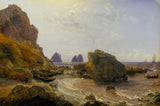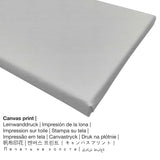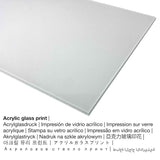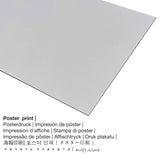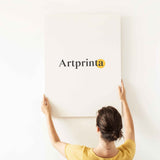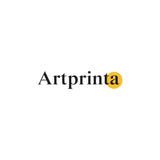Friedrich Thøming, 1829 - Echiche nke ụsọ oké osimiri nke Capri dị nso na Marina Piccola - ọmarịcha nka.
Ụtụ gụnyere. Mbupu gbakọrọ na ndenye ọpụpụ.
Họrọ ngwa ngwaahịa gị
Maka mbipụta nka ọ bụla anyị na-enye ihe & nha dị iche iche. Họrọ nha na ihe kacha amasị gị n'ime nhọrọ ndị a:
- Mbipụta akwụkwọ mmado (ihe kwaaji): The poster print is a UV printed canvas paper with a slightly roughened structure on the surface. It is excellently used for framing your fine art print with the help of a special frame. Please bear in mind, that depending on the absolute size of the poster we add a white margin between 2-6 cm around the print, which facilitates the framing with your custom frame.
- Mbipụta nke aluminom: Aluminium Dibond prints are metal prints with an impressive effect of depth - for a modern impression and non-reflective surface. The white & bright parts of the work of art shimmer with a silky gloss but without the glow. Colors are bright and luminous, fine details of the print are crisp, and you can feel the matte appearance of the product.
- Mbipụta kanvas: The printed canvas, which should not be mistaken with an artwork painted on a canvas, is a digital copy applied onto cotton canvas material. A canvas of this artwork will provide you with the chance of transforming your into a large size work of art. Canvas prints are relatively low in weight. This means, it is quite simple to hang the Canvas print without any wall-mounts. Canvas prints are suited for any type of wall.
- Ihe odide acrylic glass: A glossy acrylic glass print, which is sometimes referenced as a print on plexiglass, will convert your favorite original artwork into stunning décor. Your favorite work of art will be printed with the help of modern UV direct printing technology. It creates intense and stunning colors. Our acrylic glass protects your custom art print against light and external influences for decades.
Legal disclaimer: We try the best we can in order to depict our products as closely as possible and to exhibit them visually in our shop. Although, the tone of the printing material, as well as the printing might differ somehwat from the presentation on the screen. Depending on your screen settings and the condition of the surface, colors may not be printed 100% realistically. Considering that all fine art prints are processed and printed manually, there might also be minor variations in the motif's exact position and the size.
General information from Thorvaldsens Museum (© - by Thorvaldsens Museum - Ụlọ ihe ngosi nka Thorvaldsens)
Thöming was born at Eckernförde on the east coast of Holstein. In 1823-24 he trained at the Academy in Copenhagen as the pupil of the landscape artist J. P. Møller. Eckersberg’s marine paintings, however, were also of great significance to him. After some years in Germany, Thöming moved to Italy where, with a few interruptions, he spent the rest of his life – the winter at Rome and the summer at Naples. Thöming’s speciality was the depiction of landscapes along the coast of the Gulf of Naples. In particular the portrayal of the Blue Grotto on Capri, which was discovered in 1826, was a particular achievement that gained him great popularity. And from the beginning of the 1830s it is as though the amazing blue of the grotto spreads to the water in all his paintings of coastal scenes. In this painting, the exaggerated use of azure had not yet asserted itself in Thöming’s paintings. But this is an effective portrayal of the small natural harbour, sheltered by the characteristically projecting cliff of Scoglio delle Sirene. Along with five other Thöming acquisitions, the picture came to hang on Thorvaldsen’s wall in the Casa Buti at Rome, where many artists were able to see it. Subsequently others, including Petzholdt, Gurlitt and Købke, painted the very same locality. Both professionally and privately, the 1840s were Thöming’s happiest time. He became partly paralysed as early as 1853, and he spent the last 20 years of his life poor and neglected, incapable of painting.
Nke a ọgbara ọhụrụ nka nka e kere site Friedrich Thøming in 1829. Nke mbụ tụrụ nha: 45,8 x 80,5 cm e jirikwa teknụzụ rụọ ya mmanụ na kwaaji. Nowadays, this work of art forms part of the Thorvaldsens Museum's collection. With courtesy of: Friedrich Thøming, View of the coast of Capri near Marina Piccola, 1829, Thorvaldsens Museum, www.thorvaldsensmuseum.dk (public domain license).Besides, the artpiece has the creditline: . Moreover, alignment is in odida obodo usoro na nha onyonyo nke 3: 2, nke na-egosi na ogologo bụ 50% ogologo karịa obosara.
Data nka ahaziri
| Aha nka: | "View of the coast of Capri near Marina Piccola" |
| Nhazi nka nka: | sere |
| Okwu mkpokọta: | nkà nke oge a |
| Narị afọ nka: | 19th narị afọ |
| Afọ okike: | 1829 |
| Ogologo afọ nka nka: | 190 afọ |
| Agba na: | mmanụ na kwaaji |
| Akụkụ nke ọrụ nka mbụ: | 45,8 x 80,5 cm |
| Egosiputara na: | Ụlọ ihe ngosi nka Thorvaldsens |
| Ebe ngosi nka: | Copenhagen, Denmark |
| Dị n'okpuru: | www.thorvaldsensmuseum.dk |
| Akwụkwọ ikike nka: | ngalaba ọha |
| Site n'aka: | Friedrich Thøming, View of the coast of Capri near Marina Piccola, 1829, Thorvaldsens Museum, www.thorvaldsensmuseum.dk |
Nkọwapụta ngwaahịa
| Nkewa ngwaahịa: | nka nka |
| Usoro mmeghari: | dijitalụ mmeputakwa |
| Usoro mmepụta: | UV kpọmkwem obibi |
| Production: | emepụtara na Germany |
| Ụdị ngwaahịa: | mmepụta ihe na-achọ |
| Eji ngwaahịa emebere: | mgbidi mgbidi, mgbidi ndozi |
| Ndozi onyonyo: | usoro odida obodo |
| Oke akụkụ onyonyo: | 3: 2 ogologo: obosara |
| Ntụgharị nkọwa akụkụ: | ogologo bụ 50% ogologo karịa obosara |
| Nhọrọ dị: | akwụkwọ mmado (akwụkwọ kwaaji), mbipụta ọla (aluminium dibond), mbipụta iko acrylic (nke nwere ezigbo mkpuchi iko), mbipụta akwụkwọ. |
| Nhọrọ nha nha mbipụta kanvas (akwa akwa na etiti ihe ndọtị): | 30x20cm - 12x8", 60x40cm - 24x16", 90x60cm - 35x24" |
| Mpempe iko acrylic (nwere ezigbo mkpuchi iko) nha dị iche iche: | 30x20cm - 12x8", 60x40cm - 24x16", 90x60cm - 35x24" |
| Ụdị akwụkwọ mmado (akwụkwọ kwaaji) dị iche iche: | 60x40cm - 24x16", 90x60cm - 35x24" |
| Nhọrọ Dibond (ihe alumnium) nhọrọ: | 30x20cm - 12x8", 60x40cm - 24x16", 90x60cm - 35x24" |
| Nhazi mbipụta nka: | enweghị etiti |
Banyere omenka
| Aha onye nka: | Friedrich Thøming |
| Obodo onye nka: | Danish |
| Ọrụ nke onye na-ese ihe: | onye na-ese ihe |
| Obodo obibi: | Denmark |
| Nkewa onye nka: | omenkà nke oge a |
| Nwụrụ na afọ nke: | 71 afọ |
| Afọ ọmụmụ: | 1802 |
| Nwụrụ n'afọ: | 1873 |
© Nwebiisinka nke - Artprinta.com (Artprinta)

